Abstract
2,3,7,8-Tetrachlorodibenzo-p-dioxin (TCDD) and related halogenated aromatic hydrocarbons are a highly toxic class of environmental contaminants, as evidenced by numerous cases of accidental poisonings of human and animal populations and their extreme toxic potency in laboratory animals. The proposed model for the mechanism of action of TCDD and related compounds is analogous to that of the steroid hormones, which modulate gene expression through a receptor mechanism. In the steroid receptor model, the compound enters the cell cytoplasm where it acts as a specific ligand, binding selectively to a high affinity receptor protein. Bound to the appropriate ligand, the receptor concentrates in the nucleus where its increased association with chromatin leads to altered gene expression. This model has been useful in characterizing the Ah receptor; however, it does not provide a unifying hypothesis for all biochemical and toxic effects associated with exposure to halogenated aromatic hydrocarbons. Several findings suggest that a primary factor in determining TCDD toxicity might be tissue and species specific factors that control the actions of Ah receptor(s) in target tissues. Furthermore, numerous mechanisms might be involved. Clarifying the mechanism(s) for TCDD toxicity would enhance our ability to predict human health consequences to toxic halogenated aromatic hydrocarbons and would provide a more rational basis for risk analysis.
Full text
PDF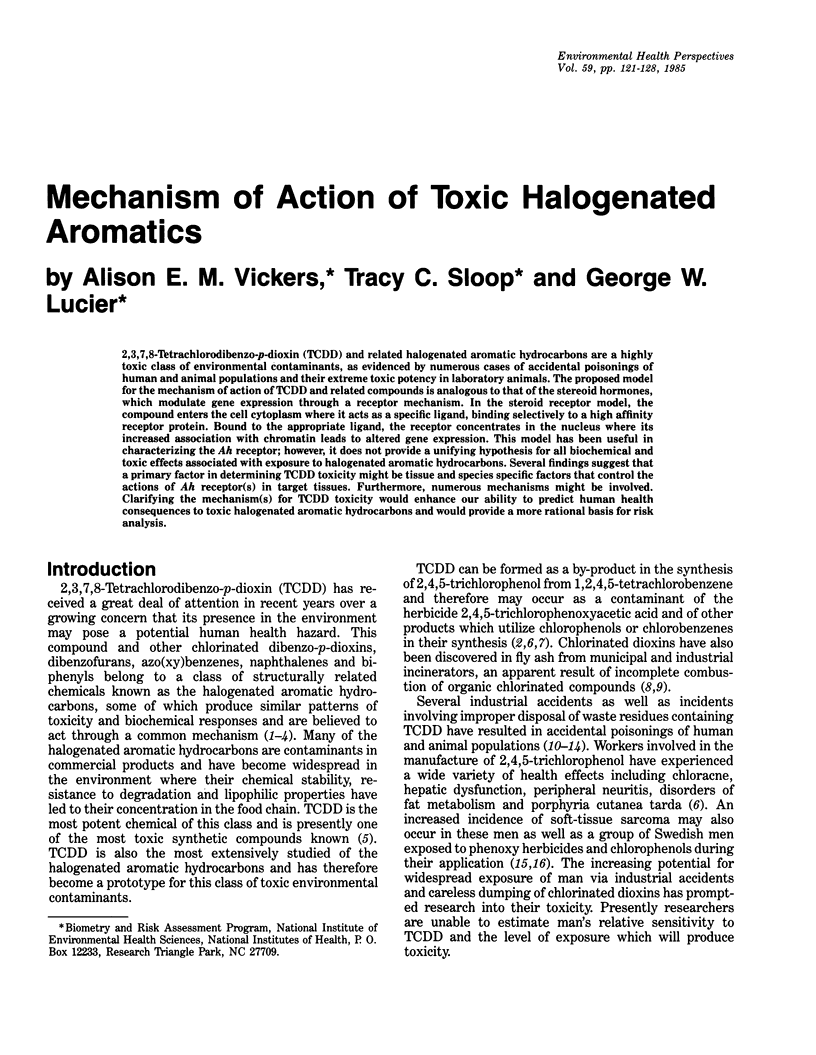

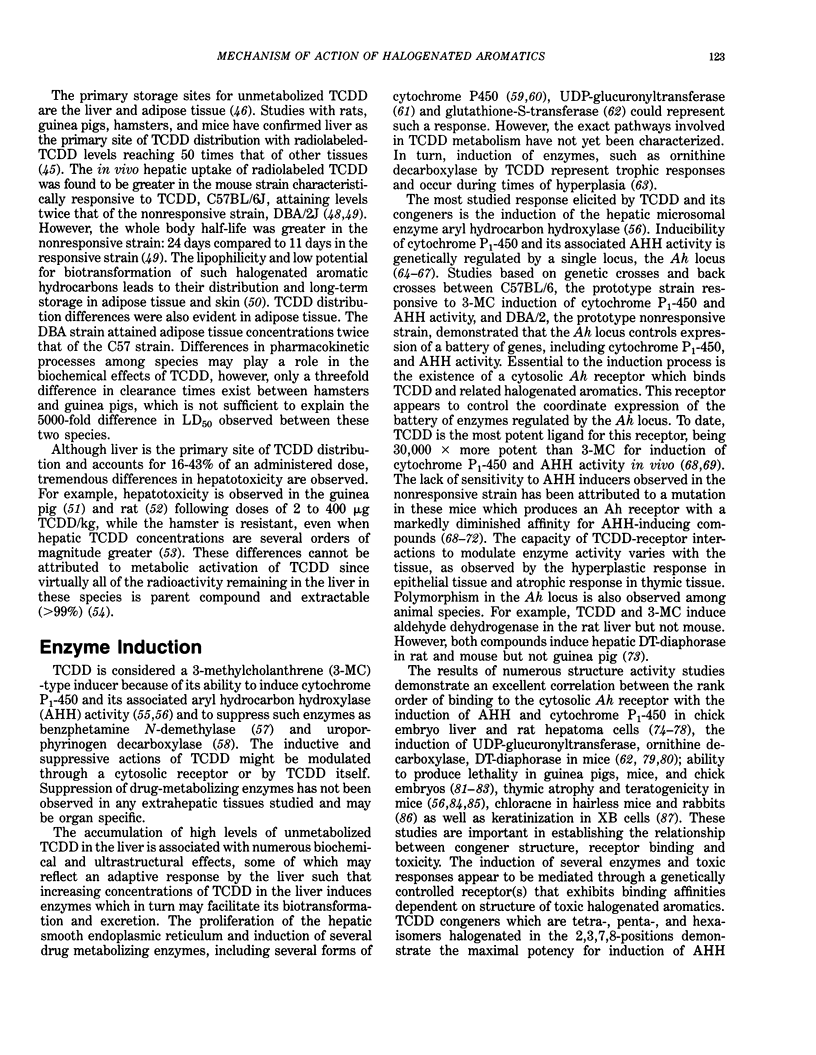
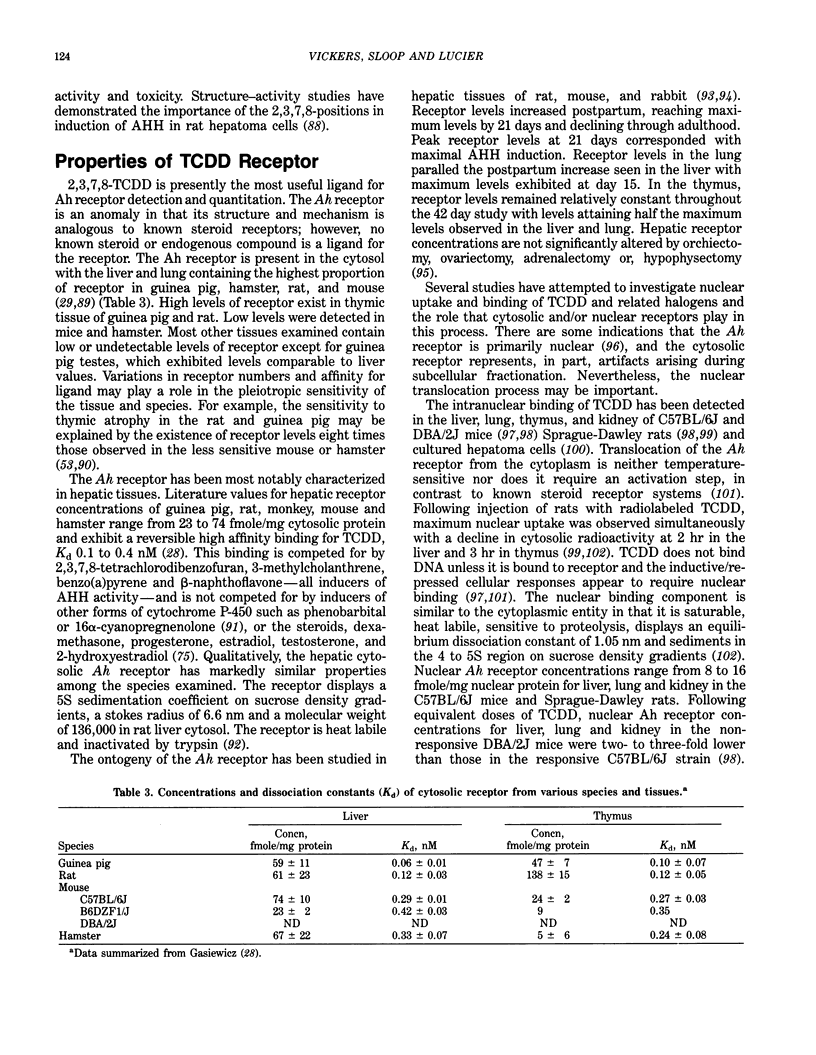
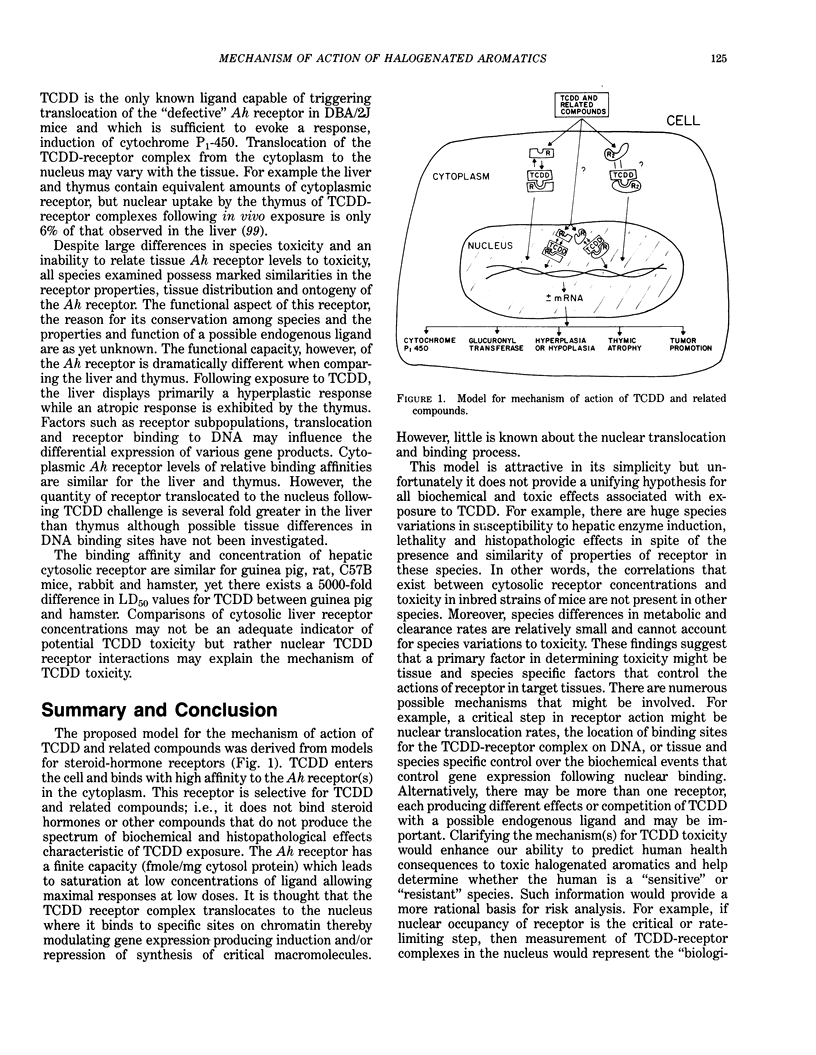
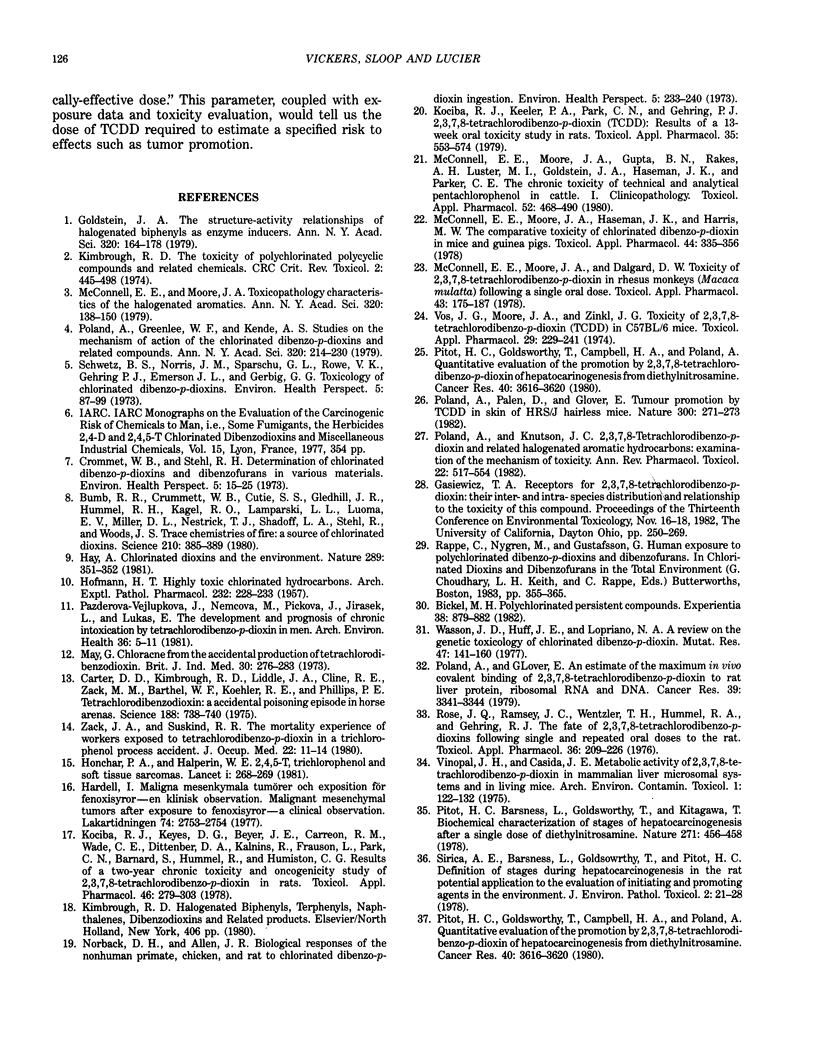
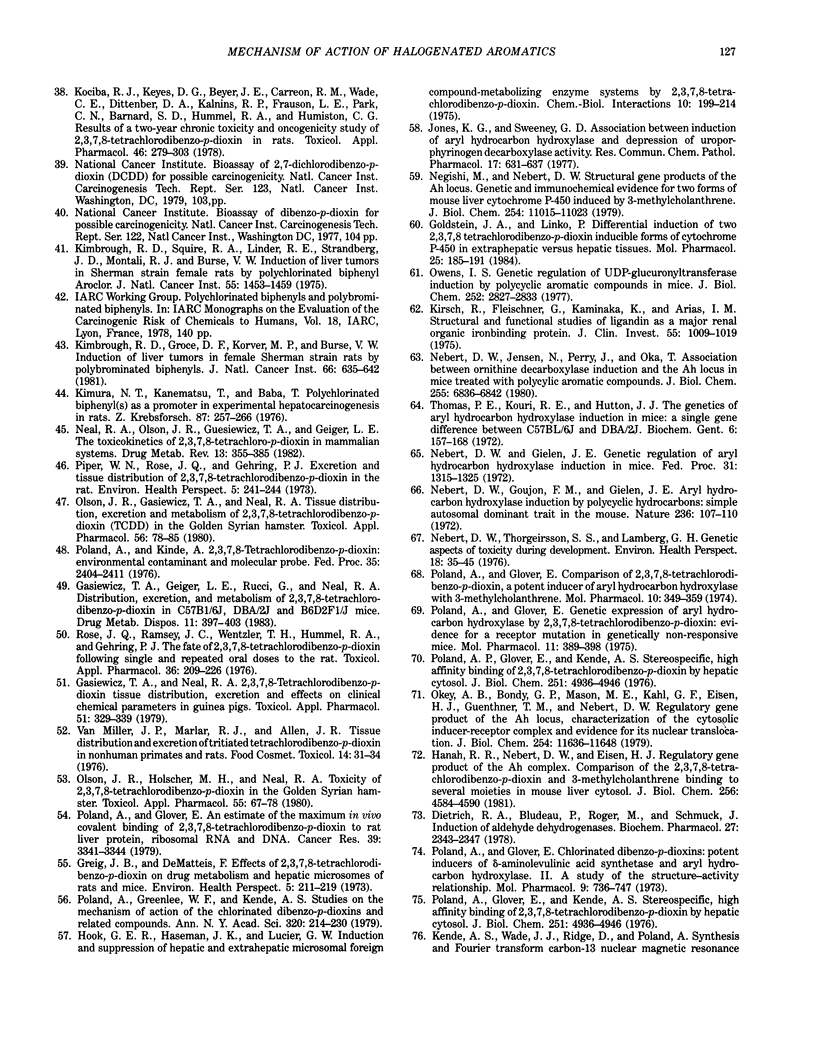
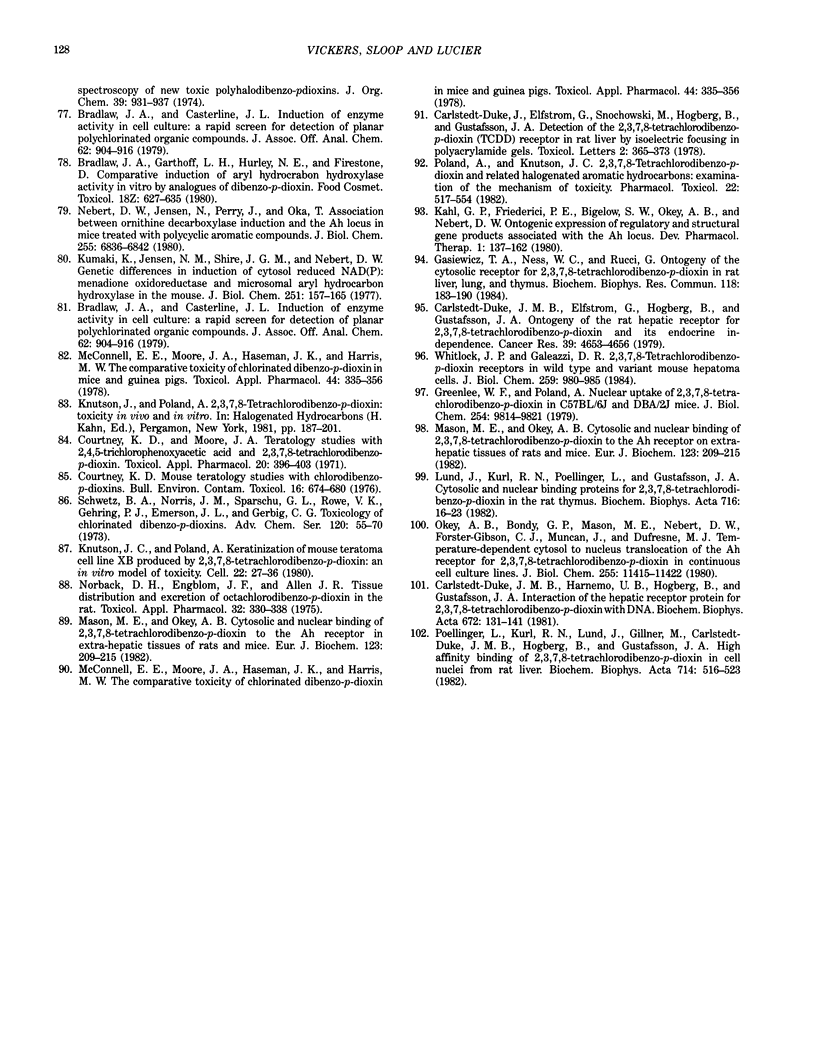
Selected References
These references are in PubMed. This may not be the complete list of references from this article.
- Bickel M. H. Polychlorinated persistent compounds. Experientia. 1982 Aug 15;38(8):879–882. doi: 10.1007/BF01953634. [DOI] [PubMed] [Google Scholar]
- Bradlaw J. A., Casterline J. L., Jr Induction of enzyme activity in cell culture: a rapid screen for detection of planar polychlorinated organic compounds. J Assoc Off Anal Chem. 1979 Jul;62(4):904–916. [PubMed] [Google Scholar]
- Bradlaw J. A., Casterline J. L., Jr Induction of enzyme activity in cell culture: a rapid screen for detection of planar polychlorinated organic compounds. J Assoc Off Anal Chem. 1979 Jul;62(4):904–916. [PubMed] [Google Scholar]
- Bradlaw J. A., Garthoff L. H., Hurley N. E., Firestone D. Comparative induction of aryl hydrocarbon hydroxylase activity in vitro by analogues of dibenzo-p-dioxin. Food Cosmet Toxicol. 1980 Dec;18(6):627–635. doi: 10.1016/s0015-6264(80)80011-3. [DOI] [PubMed] [Google Scholar]
- Bumb R. R., Crummett W. B., Cutie S. S., Gledhill J. R., Hummel R. H., Kagel R. O., Lamparski L. L., Luoma E. V., Miller D. L., Nestrick T. J. Trace chemistries of fire: a source of chlorinated dioxins. Science. 1980 Oct;210(4468):385–390. doi: 10.1126/science.6159682. [DOI] [PubMed] [Google Scholar]
- Carlstedt-Duke J. M., Elfström G., Högberg B., Gustafsson J. A. Ontogeny of the rat hepatic receptor for 2,3,7,8-tetrachlorodibenzo-p-dioxin and its endocrine indepence. Cancer Res. 1979 Nov;39(11):4653–4656. [PubMed] [Google Scholar]
- Carlstedt-Duke J. M., Harnemo U. B., Högberg B., Gustafsson J. A. Interaction of the hepatic receptor protein for 2,3,7,8-tetrachlorodibenzo-rho-dioxin with DNA. Biochim Biophys Acta. 1981 Jan 21;672(2):131–141. doi: 10.1016/0304-4165(81)90386-x. [DOI] [PubMed] [Google Scholar]
- Carter C. D., Kimbrough R. D., Liddle J. A., Cline R. E., Zack M. M., Jr, Barthel W. F., Koehler R. E., Phillips P. E. Tetrachlorodibenzodioxin: an accidental poisoning episode in horse arenas. Science. 1975 May 16;188(4189):738–740. doi: 10.1126/science.1168366. [DOI] [PubMed] [Google Scholar]
- Courtney K. D., Moore J. A. Teratology studies with 2,4,5-trichlorophenoxyacetic acid and 2,3,7,8-tetrachlorodibenzo-p-dioxin. Toxicol Appl Pharmacol. 1971 Nov;20(3):396–403. doi: 10.1016/0041-008x(71)90282-1. [DOI] [PubMed] [Google Scholar]
- Courtney K. D. Mouse teratology studies with chlorodibenzo-p-dioxins. Bull Environ Contam Toxicol. 1976 Dec;16(6):674–681. doi: 10.1007/BF01685572. [DOI] [PubMed] [Google Scholar]
- Crummett W. B., Stehl R. H. Determination of chlorinated dibenzo-p-dioxins and dibenzofurans in various materials. Environ Health Perspect. 1973 Sep;5:15–25. doi: 10.1289/ehp.730515. [DOI] [PMC free article] [PubMed] [Google Scholar]
- Gasiewicz T. A., Geiger L. E., Rucci G., Neal R. A. Distribution, excretion, and metabolism of 2,3,7,8-tetrachlorodibenzo-p-dioxin in C57BL/6J, DBA/2J, and B6D2F1/J mice. Drug Metab Dispos. 1983 Sep-Oct;11(5):397–403. [PubMed] [Google Scholar]
- Gasiewicz T. A., Neal R. A. 2,3,7,8-Tetrachlorodibenzo-p-dioxin tissue distribution, excretion, and effects on clinical chemical parameters in guinea pigs. Toxicol Appl Pharmacol. 1979 Nov;51(2):329–339. doi: 10.1016/0041-008x(79)90475-7. [DOI] [PubMed] [Google Scholar]
- Gasiewicz T. A., Ness W. C., Rucci G. Ontogeny of the cytosolic receptor for 2,3,7,8-tetrachlorodibenzo-p-dioxin in rat liver, lung, and thymus. Biochem Biophys Res Commun. 1984 Jan 13;118(1):183–190. doi: 10.1016/0006-291x(84)91084-2. [DOI] [PubMed] [Google Scholar]
- Goldstein J. A., Linko P. Differential induction of two 2,3,7,8-tetrachlorodibenzo-p-dioxin-inducible forms of cytochrome P-450 in extrahepatic versus hepatic tissues. Mol Pharmacol. 1984 Jan;25(1):185–191. [PubMed] [Google Scholar]
- Goldstein J. A. The structure-activity relationships of halogenated biphenyls as enzyme inducers. Ann N Y Acad Sci. 1979 May 31;320:164–178. [PubMed] [Google Scholar]
- Greenlee W. F., Poland A. Nuclear uptake of 2,3,7,8-tetrachlorodibenzo-p-dioxin in C57BL/6J and DBA/2J mice. Role of the hepatic cytosol receptor protein. J Biol Chem. 1979 Oct 10;254(19):9814–9821. [PubMed] [Google Scholar]
- Greig J. B., De Matteis F. Effects of 2,3,7,8-tetrachlorodibenzo-p-dioxin on drug metabolism and hepatic microsomes of rats and mice. Environ Health Perspect. 1973 Sep;5:211–219. doi: 10.1289/ehp.7305211. [DOI] [PMC free article] [PubMed] [Google Scholar]
- Hannah R. R., Nebert D. W., Eisen H. J. Regulatory gene product of the Ah complex. Comparison of 2,3,7,8-tetrachlorodibenzo-p-dioxin and 3-methylcholanthrene binding to several moieties in mouse liver cytosol. J Biol Chem. 1981 May 10;256(9):4584–4590. [PubMed] [Google Scholar]
- Hardell L. Maligna mesenkymala tumörer och exposition för fenoxisyror -- en klinisk observation. Lakartidningen. 1977 Aug 17;74(33):2753–2754. [PubMed] [Google Scholar]
- Hay A. Chlorinated dioxins and the environment. Nature. 1981 Jan 29;289(5796):351–352. doi: 10.1038/289351a0. [DOI] [PubMed] [Google Scholar]
- Honchar P. A., Halperin W. E. 2,4,5-T, trichlorophenol, and soft tissue sarcoma. Lancet. 1981 Jan 31;1(8214):268–269. doi: 10.1016/s0140-6736(81)92101-2. [DOI] [PubMed] [Google Scholar]
- Hook G. E., Haseman J. K., Lucier G. W. Induction and suppression of hepatic and extrahepatic microsomal foreign-compound-metabolizing enzyme systems by 2,3,7,8-tetrachlorodibenzo-p-dioxin. Chem Biol Interact. 1975 Mar;10(3):199–214. doi: 10.1016/0009-2797(75)90113-1. [DOI] [PubMed] [Google Scholar]
- Jones K. G., Sweeney G. D. Association between induction of aryl hydrocarbon hydroxylase and depression of uroporphyrinogen decarboxylase activity. Res Commun Chem Pathol Pharmacol. 1977 Aug;17(4):631–637. [PubMed] [Google Scholar]
- Kahl G. F., Friederici D. E., Bigelow S. W., Okey A. B., Nebert D. W. Ontogenetic expression of regulatory and structural gene products associated with the Ah locus. Comparison of rat, mouse, rabbit and Sigmoden hispedis. Dev Pharmacol Ther. 1980;1(2-3):137–162. [PubMed] [Google Scholar]
- Kimbrough R. D., Squire R. A., Linder R. E., Strandberg J. D., Montalli R. J., Burse V. W. Induction of liver tumor in Sherman strain female rats by polychlorinated biphenyl aroclor 1260. J Natl Cancer Inst. 1975 Dec;55(6):1453–1459. doi: 10.1093/jnci/55.6.1453. [DOI] [PubMed] [Google Scholar]
- Kimbrough R. D. The toxicity of polychlorinated polycyclic compounds and related chemicals. CRC Crit Rev Toxicol. 1974 Jan;2(4):445–498. doi: 10.3109/10408447309025705. [DOI] [PubMed] [Google Scholar]
- Kimura N. T., Kanematsu T., Baba T. Polychlorinated biphenyl(s) as a promotor in experimental hepatocarcinogenesis in rats. Z Krebsforsch Klin Onkol Cancer Res Clin Oncol. 1976 Dec 9;87(3):257–266. doi: 10.1007/BF00506498. [DOI] [PubMed] [Google Scholar]
- Kirsch R., Fleischner G., Kamisaka K., Arias I. M. Structural and functional studies of ligandin, a major renal organic anion-binding protein. J Clin Invest. 1975 May;55(5):1009–1019. doi: 10.1172/JCI108001. [DOI] [PMC free article] [PubMed] [Google Scholar]
- Knutson J. C., Poland A. Keratinization of mouse teratoma cell line XB produced by 2,3,7,8-tetrachlorodibenzo-p-dioxin: an in vitro model of toxicity. Cell. 1980 Nov;22(1 Pt 1):27–36. doi: 10.1016/0092-8674(80)90151-8. [DOI] [PubMed] [Google Scholar]
- Kociba R. J., Keeler P. A., Park C. N., Gehring P. J. 2,3,7,8-tetrachlorodibenzo-p-dioxin (TCDD): results of a 13-week oral toxicity study in rats. Toxicol Appl Pharmacol. 1976 Mar;35(3):553–574. doi: 10.1016/0041-008x(76)90078-8. [DOI] [PubMed] [Google Scholar]
- Kociba R. J., Keyes D. G., Beyer J. E., Carreon R. M., Wade C. E., Dittenber D. A., Kalnins R. P., Frauson L. E., Park C. N., Barnard S. D. Results of a two-year chronic toxicity and oncogenicity study of 2,3,7,8-tetrachlorodibenzo-p-dioxin in rats. Toxicol Appl Pharmacol. 1978 Nov;46(2):279–303. doi: 10.1016/0041-008x(78)90075-3. [DOI] [PubMed] [Google Scholar]
- Lund J., Kurl R. N., Poellinger L., Gustafsson J. A. Cytosolic and nuclear binding proteins for 2,3,7,8-tetrachlorodibenzo-p-dioxin in the rat thymus. Biochim Biophys Acta. 1982 May 5;716(1):16–23. doi: 10.1016/0304-4165(82)90197-0. [DOI] [PubMed] [Google Scholar]
- Mason M. E., Okey A. B. Cytosolic and nuclear binding of 2,3,7,8-tetrachlorodibenzo-p-dioxin to the Ah receptor in extra-hepatic tissues of rats and mice. Eur J Biochem. 1982 Mar;123(1):209–215. doi: 10.1111/j.1432-1033.1982.tb06518.x. [DOI] [PubMed] [Google Scholar]
- Mason M. E., Okey A. B. Cytosolic and nuclear binding of 2,3,7,8-tetrachlorodibenzo-p-dioxin to the Ah receptor in extra-hepatic tissues of rats and mice. Eur J Biochem. 1982 Mar;123(1):209–215. doi: 10.1111/j.1432-1033.1982.tb06518.x. [DOI] [PubMed] [Google Scholar]
- May G. Chloracne from the accidental production of tetrachlorodibenzodioxin. Br J Ind Med. 1973 Jul;30(3):276–283. doi: 10.1136/oem.30.3.276. [DOI] [PMC free article] [PubMed] [Google Scholar]
- McConnell E. E., Moore J. A., Dalgard D. W. Toxicity of 2,3,7,8-tetrachlorodibenzo-p-dioxin in rhesus monkeys (Macaca mulatta) following a single oral dose. Toxicol Appl Pharmacol. 1978 Jan;43(1):175–187. doi: 10.1016/s0041-008x(78)80042-8. [DOI] [PubMed] [Google Scholar]
- McConnell E. E., Moore J. A., Gupta B. N., Rakes A. H., Luster M. I., Goldstein J. A., Haseman J. K., Parker C. E. The chronic toxicity of technical and analytical pentachlorophenol in cattle. I. Clinicopathology. Toxicol Appl Pharmacol. 1980 Mar 15;52(3):468–490. doi: 10.1016/0041-008x(80)90342-7. [DOI] [PubMed] [Google Scholar]
- McConnell E. E., Moore J. A., Haseman J. K., Harris M. W. The comparative toxicity of chlorinated dibenzo-p-dioxins in mice and guinea pigs. Toxicol Appl Pharmacol. 1978 May;44(2):335–356. doi: 10.1016/0041-008x(78)90195-3. [DOI] [PubMed] [Google Scholar]
- McConnell E. E., Moore J. A., Haseman J. K., Harris M. W. The comparative toxicity of chlorinated dibenzo-p-dioxins in mice and guinea pigs. Toxicol Appl Pharmacol. 1978 May;44(2):335–356. doi: 10.1016/0041-008x(78)90195-3. [DOI] [PubMed] [Google Scholar]
- McConnell E. E., Moore J. A., Haseman J. K., Harris M. W. The comparative toxicity of chlorinated dibenzo-p-dioxins in mice and guinea pigs. Toxicol Appl Pharmacol. 1978 May;44(2):335–356. doi: 10.1016/0041-008x(78)90195-3. [DOI] [PubMed] [Google Scholar]
- McConnell E. E., Moore J. A. Toxicopathology characteristics of the halogenated aromatics. Ann N Y Acad Sci. 1979 May 31;320:138–150. [PubMed] [Google Scholar]
- Neal R. A., Olson J. R., Gasiewicz T. A., Geiger L. E. The toxicokinetics of 2, 3, 7, 8-tetrachlorodibenzo-p-dioxin in mammalian systems. Drug Metab Rev. 1982;13(3):355–385. doi: 10.3109/03602538209029985. [DOI] [PubMed] [Google Scholar]
- Nebert D. W., Gielen J. E. Genetic regulation of aryl hydrocarbon hydroxylase induction in the mouse. Fed Proc. 1972 Jul-Aug;31(4):1315–1325. [PubMed] [Google Scholar]
- Nebert D. W., Goujon F. M., Gielen J. E. Aryl hydrocarbon hydroxylase induction by polycyclic hydrocarbons: simple autosomal dominant trait in the mouse. Nat New Biol. 1972 Mar 29;236(65):107–110. doi: 10.1038/newbio236107a0. [DOI] [PubMed] [Google Scholar]
- Nebert D. W., Jensen N. M., Perry J. W., Oka T. Association between ornithine decarboxylase induction and the Ah locus in mice treated with polycyclic aromatic compounds. J Biol Chem. 1980 Jul 25;255(14):6836–6842. [PubMed] [Google Scholar]
- Nebert D. W., Jensen N. M., Perry J. W., Oka T. Association between ornithine decarboxylase induction and the Ah locus in mice treated with polycyclic aromatic compounds. J Biol Chem. 1980 Jul 25;255(14):6836–6842. [PubMed] [Google Scholar]
- Nebert D. W., Thorgeirsson S. S., Lambert G. H. Genetic aspects of toxicity during development. Environ Health Perspect. 1976 Dec;18:35–45. doi: 10.1289/ehp.761835. [DOI] [PMC free article] [PubMed] [Google Scholar]
- Negishi M., Nebert D. W. Structural gene products of the Ah locus. Genetic and immunochemical evidence for two forms of mouse liver cytochrome P-450 induced by 3-methylcholanthrene. J Biol Chem. 1979 Nov 10;254(21):11015–11023. [PubMed] [Google Scholar]
- Norback D. H., Allen J. R. Biological responses of the nonhuman primate, chicken, and rat to chlorinated dibenzo-p-dioxin ingestion. Environ Health Perspect. 1973 Sep;5:233–240. doi: 10.1289/ehp.7305233. [DOI] [PMC free article] [PubMed] [Google Scholar]
- Norback D. H., Engblom J. F., Allen J. R. Tissue distribution and excretion of octachlorodibenzo-rho-dioxin in the rat. Toxicol Appl Pharmacol. 1975 May;32(2):330–338. doi: 10.1016/0041-008x(75)90223-9. [DOI] [PubMed] [Google Scholar]
- Okey A. B., Bondy G. P., Mason M. E., Kahl G. F., Eisen H. J., Guenthner T. M., Nebert D. W. Regulatory gene product of the Ah locus. Characterization of the cytosolic inducer-receptor complex and evidence for its nuclear translocation. J Biol Chem. 1979 Nov 25;254(22):11636–11648. [PubMed] [Google Scholar]
- Okey A. B., Bondy G. P., Mason M. E., Nebert D. W., Forster-Gibson C. J., Muncan J., Dufresne M. J. Temperature-dependent cytosol-to-nucleus translocation of the Ah receptor for 2,3,7,8-tetrachlorodibenzo-p-dioxin in continuous cell culture lines. J Biol Chem. 1980 Dec 10;255(23):11415–11422. [PubMed] [Google Scholar]
- Olson J. R., Gasiewicz T. A., Neal R. A. Tissue distribution, excretion, and metabolism of 2,3,7,8-tetrachlorodibenzo-p-dioxin (TCDD) in the Golden Syrian hamster. Toxicol Appl Pharmacol. 1980 Oct;56(1):78–85. doi: 10.1016/0041-008x(80)90132-5. [DOI] [PubMed] [Google Scholar]
- Olson J. R., Holscher M. A., Neal R. A. Toxicity of 2,3,7,8-tetrachlorodibenzo-p-dioxin in the golden Syrian hamster. Toxicol Appl Pharmacol. 1980 Aug;55(1):67–78. doi: 10.1016/0041-008x(80)90221-5. [DOI] [PubMed] [Google Scholar]
- Owens I. S. Genetic regulation of UDP-glucuronosyltransferase induction by polycyclic aromatic compounds in mice. Co-segregation with aryl hydrocarbon (benzo(alpha)pyrene) hydroxylase induction. J Biol Chem. 1977 May 10;252(9):2827–2833. [PubMed] [Google Scholar]
- Pazderova-Vejlupková J., Lukás E., Nemcova M., Pícková J., Jirásek L. The development and prognosis of chronic intoxication by tetrachlordibenzo-p-dioxin in men. Arch Environ Health. 1981 Jan-Feb;36(1):5–11. doi: 10.1080/00039896.1981.10667598. [DOI] [PubMed] [Google Scholar]
- Piper W. N., Rose J. Q., Gehring P. J. Excretion and tissue distribution of 2,3,7,8-tetrachlorodibenzo-p-dioxin in the rat. Environ Health Perspect. 1973 Sep;5:241–244. doi: 10.1289/ehp.7305241. [DOI] [PMC free article] [PubMed] [Google Scholar]
- Pitot H. C., Barsness L., Goldsworthy T., Kitagawa T. Biochemical characterisation of stages of hepatocarcinogenesis after a single dose of diethylnitrosamine. Nature. 1978 Feb 2;271(5644):456–458. doi: 10.1038/271456a0. [DOI] [PubMed] [Google Scholar]
- Pitot H. C., Goldsworthy T., Campbell H. A., Poland A. Quantitative evaluation of the promotion by 2,3,7,8-tetrachlorodibenzo-p-dioxin of hepatocarcinogenesis from diethylnitrosamine. Cancer Res. 1980 Oct;40(10):3616–3620. [PubMed] [Google Scholar]
- Pitot H. C., Goldsworthy T., Campbell H. A., Poland A. Quantitative evaluation of the promotion by 2,3,7,8-tetrachlorodibenzo-p-dioxin of hepatocarcinogenesis from diethylnitrosamine. Cancer Res. 1980 Oct;40(10):3616–3620. [PubMed] [Google Scholar]
- Poellinger L., Kurl R. N., Lund J., Gillner M., Carlstedt-Duke J., Högberg B., Gustafsson J. A. High-affinity binding of 2,3,7,8-tetrachlorodibenzo-p-dioxin in cell nuclei from rat liver. Biochim Biophys Acta. 1982 Feb 25;714(3):516–523. doi: 10.1016/0304-4165(82)90162-3. [DOI] [PubMed] [Google Scholar]
- Poland A., Glover E. An estimate of the maximum in vivo covalent binding of 2,3,7,8-tetrachlorodibenzo-p-dioxin to rat liver protein, ribosomal RNA, and DNA. Cancer Res. 1979 Sep;39(9):3341–3344. [PubMed] [Google Scholar]
- Poland A., Glover E. An estimate of the maximum in vivo covalent binding of 2,3,7,8-tetrachlorodibenzo-p-dioxin to rat liver protein, ribosomal RNA, and DNA. Cancer Res. 1979 Sep;39(9):3341–3344. [PubMed] [Google Scholar]
- Poland A., Glover E. Chlorinated dibenzo-p-dioxins: potent inducers of delta-aminolevulinic acid synthetase and aryl hydrocarbon hydroxylase. II. A study of the structure-activity relationship. Mol Pharmacol. 1973 Nov;9(6):736–747. [PubMed] [Google Scholar]
- Poland A., Glover E. Comparison of 2,3,7,8-tetrachlorodibenzo-p-dioxin, a potent inducer of aryl hydrocarbon hydroxylase, with 3-methylcholanthrene. Mol Pharmacol. 1974 Mar;10(2):349–359. [PubMed] [Google Scholar]
- Poland A., Glover E., Kende A. S. Stereospecific, high affinity binding of 2,3,7,8-tetrachlorodibenzo-p-dioxin by hepatic cytosol. Evidence that the binding species is receptor for induction of aryl hydrocarbon hydroxylase. J Biol Chem. 1976 Aug 25;251(16):4936–4946. [PubMed] [Google Scholar]
- Poland A., Glover E., Kende A. S. Stereospecific, high affinity binding of 2,3,7,8-tetrachlorodibenzo-p-dioxin by hepatic cytosol. Evidence that the binding species is receptor for induction of aryl hydrocarbon hydroxylase. J Biol Chem. 1976 Aug 25;251(16):4936–4946. [PubMed] [Google Scholar]
- Poland A., Greenlee W. F., Kende A. S. Studies on the mechanism of action of the chlorinated dibenzo-p-dioxins and related compounds. Ann N Y Acad Sci. 1979 May 31;320:214–230. doi: 10.1111/j.1749-6632.1979.tb56603.x. [DOI] [PubMed] [Google Scholar]
- Poland A., Greenlee W. F., Kende A. S. Studies on the mechanism of action of the chlorinated dibenzo-p-dioxins and related compounds. Ann N Y Acad Sci. 1979 May 31;320:214–230. doi: 10.1111/j.1749-6632.1979.tb56603.x. [DOI] [PubMed] [Google Scholar]
- Poland A., Kende A. 2,3,7,8-Tetrachlorodibenzo-p-dioxin: environmental contaminant and molecular probe. Fed Proc. 1976 Oct;35(12):2404–2411. [PubMed] [Google Scholar]
- Poland A., Knutson J. C. 2,3,7,8-tetrachlorodibenzo-p-dioxin and related halogenated aromatic hydrocarbons: examination of the mechanism of toxicity. Annu Rev Pharmacol Toxicol. 1982;22:517–554. doi: 10.1146/annurev.pa.22.040182.002505. [DOI] [PubMed] [Google Scholar]
- Poland A., Knutson J. C. 2,3,7,8-tetrachlorodibenzo-p-dioxin and related halogenated aromatic hydrocarbons: examination of the mechanism of toxicity. Annu Rev Pharmacol Toxicol. 1982;22:517–554. doi: 10.1146/annurev.pa.22.040182.002505. [DOI] [PubMed] [Google Scholar]
- Poland A., Palen D., Glover E. Tumour promotion by TCDD in skin of HRS/J hairless mice. Nature. 1982 Nov 18;300(5889):271–273. doi: 10.1038/300271a0. [DOI] [PubMed] [Google Scholar]
- Rose J. Q., Ramsey J. C., Wentzler T. H., Hummel R. A., Gehring P. J. The fate of 2,3,7,8-tetrachlorodibenzo-p-dioxin following single and repeated oral doses to the rat. Toxicol Appl Pharmacol. 1976 May;36(2):209–226. doi: 10.1016/0041-008x(76)90001-6. [DOI] [PubMed] [Google Scholar]
- Rose J. Q., Ramsey J. C., Wentzler T. H., Hummel R. A., Gehring P. J. The fate of 2,3,7,8-tetrachlorodibenzo-p-dioxin following single and repeated oral doses to the rat. Toxicol Appl Pharmacol. 1976 May;36(2):209–226. doi: 10.1016/0041-008x(76)90001-6. [DOI] [PubMed] [Google Scholar]
- Schwetz B. A., Norris J. M., Sparschu G. L., Rowe U. K., Gehring P. J., Emerson J. L., Gerbig C. G. Toxicology of chlorinated dibenzo-p-dioxins. Environ Health Perspect. 1973 Sep;5:87–99. doi: 10.1289/ehp.730587. [DOI] [PMC free article] [PubMed] [Google Scholar]
- Sirica A. E., Barsness L., Goldsworthy T., Pitot H. C. Definition of stages during hepatocarcinogenesis in the rat: potential application to the evaluation of initiating and promoting agents in the environment. J Environ Pathol Toxicol. 1978 Sep-Oct;2(1):21–28. [PubMed] [Google Scholar]
- Thomas P. E., Kouri R. E., Hutton J. J. The genetics of aryl hydrocarbon hydroxylase induction in mice: a single gene difference between C57BL-6J and DBA-2J. Biochem Genet. 1972 Apr;6(2):157–168. doi: 10.1007/BF00486400. [DOI] [PubMed] [Google Scholar]
- Van Miller J. P., Marlar R. J., Allen J. R. Tissue distribution and excretion of tritiated tetrachlorodibenzo-p-doxin in non-human primates and rats. Food Cosmet Toxicol. 1976 Jan;14(1):31–34. doi: 10.1016/s0015-6264(76)80360-4. [DOI] [PubMed] [Google Scholar]
- Vinopal J. H., Casida J. E. Metabolic stability of 2, 3, 7, 8-tetrachlorodibenzo-P-dioxin in mammalian liver microsomal systems and in living mice. Arch Environ Contam Toxicol. 1973 Jul;1(2):122–132. doi: 10.1007/BF01986002. [DOI] [PubMed] [Google Scholar]
- Vos J. G., Moore J. A., Zinkl J. G. Toxicity of 2,3,7,8-tetrachlorodibenzo-p-dioxin (TCDD) in C57B1/6 mice. Toxicol Appl Pharmacol. 1974 Aug;29(2):229–241. doi: 10.1016/0041-008x(74)90060-x. [DOI] [PubMed] [Google Scholar]
- Wassom J. S., Huff J. E., Loprieno N. A review of the genetic toxicology of chlorinated dibenzo-p-dioxins. Mutat Res. 1977;47(3-4):141–160. doi: 10.1016/0165-1110(77)90001-x. [DOI] [PubMed] [Google Scholar]
- Whitlock J. P., Jr, Galeazzi D. R. 2,3,7,8-Tetrachlorodibenzo-p-dioxin receptors in wild type and variant mouse hepatoma cells. Nuclear location and strength of nuclear binding. J Biol Chem. 1984 Jan 25;259(2):980–985. [PubMed] [Google Scholar]
- Zack J. A., Suskind R. R. The mortality experience of workers exposed to tetrachlorodibenzodioxin in a trichlorophenol process accident. J Occup Med. 1980 Jan;22(1):11–14. [PubMed] [Google Scholar]


